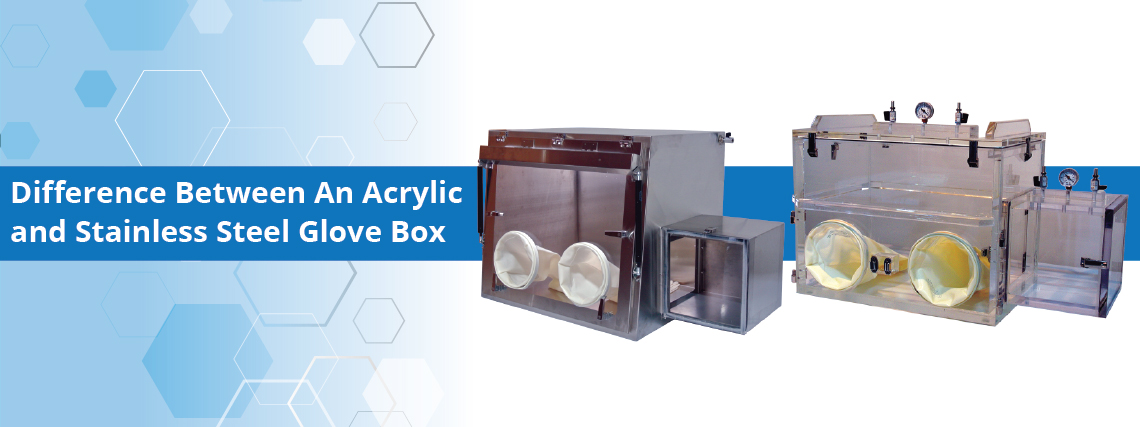What is a glovebox?
A glovebox is a sealed container designed with built-in gloves allowing users to perform tasks inside the chamber where a different atmosphere is required. These containers are typically constructed with clear plastic or stainless steel with a window for viewing to allow the user to see they are manipulating.
There are two types of gloveboxes. The first is allows laboratory personnel to work with hazardous material and the second allows for material to be handled that requires a very high purity inert atmosphere. A glovebox can also be used to handle objects in a vacuum chamber.
Shielded glove boxes are typically constructed with heavy-duty stainless steel, lead radiation shielding, and a lead glass viewing window to protect users from radiation. These containers allow users to safely handle radioactive material or infectious disease agents.
Inert atmosphere glovebox isolators or containment chambers are built with clear acrylic material. These glove boxes are ideal when working with powder substance or electrical components where a hermetically sealed environment is needed. Nitrogen or argon is typically used to remove oxygen and humidity within the chamber to prevent damage object within the main chamber.
Where are glove boxes used?
Glove boxes can be found in laboratories and cleanrooms for pharmaceutical manufacturing, semiconductor manufacturing, Additive (3D printing) Manufacturing, chemical research, and biological research.
Acrylic (Plastic) Glove Box vs Stainless Steel Glove Box
What is the difference between an acrylic and stainless steel glove box? The obvious answer here is the material used in the construct the glovebox. What are some of the advantages and disadvantages of acrylic and stainless steel?
Advantages of Stainless Steel Material
Corrosion Resistance
A thin layer oxide on the surface gives stainless steel its corrosion resistance. This layer of oxide is formed when chromium is added to stainless steel. This allows for a wide range of application to be worked on.
Durable
One of the attractive properties of stainless steel is its durability. Due to its strength, corrosion resistance properties, and flexibility stainless steel is commonly used in construction, automotive, medical, food, and energy industry.
ESD-Safe Stainless steel is a poor conductor of electricity. Electrostatic discharge can cause electrostatic-sensitive components to short or can cause dust, fumes or other vapors to ignite.
Hygienic Another attractive property of stainless steel is hygiene. Having no pores or cracks makes it impossible to harbor bacteria, viruses or dirt. For this reason alone, stainless steel is used in food and pharmaceutical processing facilities, hospitals, and residential/commercial kitchens.
Aesthetic Appearance
Stainless steel is easily one of the aesthetically pleasing materials.
Disadvantages of Stainless Steel Material
Weight
The drawback of the durability of this material is the weight. A stainless steel glove box may need a worktable or stand sturdy enough to hold the weight
Expensive
Due to its variety of alloying elements, stainless steel is not a cheap material.
Easily Scratches
Even though we mentioned durability, scratches are very common on the stainless steel surface. Cleaning the surface incorrectly can cause scratches, and precaution must be taken while maintaining your glove box.
Advantages of Acrylic Material
Light-Weight
An advantage of acrylic is its weight. It is 50% lighter than glass but much stronger.
Cost Effective
When compared, an acrylic glove box is half the price of a stainless steel glove box.
Impact Resistant
Acrylic is 4-5 times more impact resistant than glass.
Disadvantages of Acrylic Material
Non-Chemical Resistant
Depending on your application, acrylic may not be suitable for ammonia-based chemicals. This means Windex or home glass cleaner can ruin an acrylic glove box.
Heat Damage
Exposing acrylic to high heat can cause the acrylic to warp causing severe damage.
Easily Scratches
Just like stainless steel, acrylic is prone to scratches while cleaning your product.
Non-ESD-Safe
Acrylic is a magnet for dust and can hold a charge similar to a ballon causing electrical components to short. ESD-safe Acrylic is available but is more expensive.

